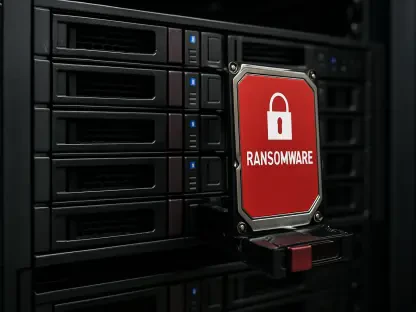In today’s fast-paced digital landscape, businesses are increasingly turning to multi-cloud environments to drive innovation, scalability, and flexibility, utilizing platforms such as AWS, Azure, and Google Cloud to meet diverse operational needs. However, with these advantages comes a significant downside: the sprawling complexity of securing distributed systems across multiple providers. Each platform introduces unique configurations and management challenges, expanding the attack surface and exposing organizations to sophisticated cyber threats. By 2026, as adoption of multi-cloud systems accelerates, the urgency to address these vulnerabilities will intensify, compelling enterprises to rethink their security paradigms. Traditional approaches, often rooted in static defenses, are proving inadequate against the dynamic nature of modern attacks, leaving companies at risk of operational disruption and financial loss.
The concept of cyber resilience is emerging as a transformative solution, shifting the focus from merely preventing breaches to enduring them, recovering swiftly, and maintaining business continuity under adverse conditions. Unlike conventional cybersecurity, which prioritizes building impenetrable barriers, resilience acknowledges that breaches are inevitable in a distributed world and prepares organizations to operate through them. As cyber threats evolve in both frequency and complexity, resilience is poised to become a strategic imperative by 2026, directly influencing how enterprises protect their digital ecosystems. This shift is not just technical but also a business necessity, impacting trust, reliability, and competitive standing in an interconnected market.
The Shift to Cyber Resilience
Why Traditional Security Falls Short
The foundation of traditional cybersecurity, designed for static, perimeter-based environments, is crumbling under the weight of multi-cloud architectures that span diverse platforms and geographies. These older models assume a defined boundary where trust can be established, but in a multi-cloud setup, such boundaries are fluid, with data and workloads moving dynamically across environments. Issues like fragmented identity management—where each cloud provider uses different authentication systems—create inconsistencies that attackers exploit. Additionally, slow incident response times and outdated trust assumptions, such as flat network policies, leave gaping vulnerabilities. By 2026, as multi-cloud adoption grows, these shortcomings will become even more pronounced, necessitating a fundamental overhaul of security strategies to address the distributed nature of modern IT systems.
Another critical weakness lies in the lack of unified visibility across multi-cloud environments, where disparate logging and monitoring tools hinder a comprehensive view of potential threats. Without centralized oversight, detecting anomalies or coordinating responses becomes a logistical nightmare, often delaying critical actions during a breach. Traditional controls, which are often static and reactive, fail to adapt to the rapid pace of cyber threats targeting cloud systems. This gap exposes organizations to prolonged downtime and reputational damage, underscoring the need for a more agile, proactive framework. As the attack surface expands with each additional cloud provider, the limitations of legacy security approaches will drive enterprises toward resilience-focused models that prioritize adaptability over rigid defense mechanisms.
Defining Resilience Over Prevention
Cyber resilience marks a significant departure from traditional prevention-centric strategies by emphasizing a holistic approach built on four core pillars: anticipation of threats, endurance during attacks, rapid recovery post-incident, and operational continuity under stress. This mindset acknowledges that in a multi-cloud world, preventing every breach is an unrealistic goal, especially as attackers leverage advanced tactics to exploit distributed systems. Instead, resilience focuses on preparing for inevitable disruptions, ensuring that businesses can maintain critical functions even when under siege. By 2026, organizations adopting this approach will likely see reduced impact from cyber incidents, preserving stakeholder trust and minimizing financial losses through strategic foresight and robust recovery plans.
Beyond just technical readiness, cyber resilience integrates business objectives into security planning, aligning IT capabilities with the need for uptime and reliability in customer-facing operations. This involves not only deploying advanced tools but also fostering a culture of preparedness across departments, from IT teams to executive leadership. Companies that embed resilience into their frameworks will be better positioned to handle the projected 30% increase in multi-cloud attacks by 2026, turning potential crises into manageable challenges. The emphasis on quick recovery and sustained operations distinguishes resilience as a forward-thinking strategy, ensuring that even in the face of sophisticated threats, enterprises can maintain momentum and safeguard their competitive edge in a digital-first economy.
Core Strategies for Multi-Cloud Security
Zero Trust as the New Foundation
Zero Trust architecture is rapidly becoming a cornerstone for securing multi-cloud environments, fundamentally rejecting the notion of inherent trust in any user, device, or connection, regardless of location. This approach redefines security by treating identity as the new perimeter, requiring continuous verification through mechanisms like multi-factor authentication and real-time device health assessments. In multi-cloud setups, where workloads and data traverse multiple platforms, Zero Trust implements micro-segmentation of networks and context-aware access controls to limit lateral movement by attackers. By 2026, this framework will likely be indispensable for organizations aiming to mitigate risks across distributed systems, ensuring that access is granted only on a need-to-know basis with rigorous policy enforcement at every level.
The strength of Zero Trust lies in its adaptability to the boundary-less nature of multi-cloud architectures, addressing vulnerabilities introduced by fragmented security controls and diverse provider policies. Unlike traditional models that assume safety within a network, Zero Trust operates on the principle that threats can originate from anywhere, necessitating constant scrutiny of every interaction. This granular control is particularly vital as identity-based attacks in federated cloud environments continue to surge, with statistics indicating significant increases in such threats. As businesses scale their multi-cloud operations, adopting Zero Trust will provide a robust defense mechanism, minimizing the risk of unauthorized access and enabling a more secure, resilient digital ecosystem by 2026.
AI and Automation Driving Efficiency
Artificial Intelligence (AI) is transforming the landscape of cyber resilience by equipping organizations with tools to detect threats and identify anomalies in real-time across vast multi-cloud environments. These AI-driven solutions analyze massive datasets to uncover patterns that human analysts might miss, flagging potential breaches before they escalate into full-blown crises. By integrating machine learning, these systems continuously improve their accuracy, adapting to new attack vectors as they emerge. With cyber threats growing in sophistication, AI’s ability to provide predictive insights and prioritize critical alerts will be a game-changer by 2026, enabling security teams to focus on strategic responses rather than being overwhelmed by the volume of potential risks in distributed cloud systems.
Automation complements AI by streamlining repetitive security tasks, significantly reducing human error and accelerating response times in multi-cloud setups. Processes such as policy enforcement, identity quarantine during suspicious activity, and workload isolation can be executed instantly, minimizing the window of opportunity for attackers. This efficiency is crucial in environments where manual intervention cannot keep pace with the scale and speed of threats. By 2026, organizations leveraging automation will likely see substantial reductions in breach impact, as automated systems handle routine defenses and free up resources for complex problem-solving. The synergy of AI and automation creates a powerful shield, ensuring that multi-cloud security keeps up with the relentless evolution of cyber risks.
Building a Resilient Architecture
Multi-Layered Protection for Comprehensive Defense
Creating a resilient security framework for multi-cloud environments demands a multi-layered approach that addresses vulnerabilities across identity, network, data, applications, and operational domains. At the identity level, strong multi-factor authentication (MFA) ensures that access is tightly controlled, while network segmentation limits the spread of an attack by isolating workloads. Data encryption, both at rest and in transit, safeguards sensitive information from unauthorized access, and robust API security protects the interfaces that connect cloud services. By 2026, embedding these layered defenses will be critical for organizations to not only prevent breaches but also to contain and recover from them swiftly, ensuring that no single point of failure can compromise the entire system.
Operational resilience further enhances this framework through automated incident response playbooks that enable rapid reaction to detected threats, minimizing downtime and disruption. This comprehensive strategy ensures that each component of a multi-cloud system is fortified against specific risks, creating a cohesive defense that traditional, singular approaches cannot match. The integration of real-time observability tools also plays a key role, providing continuous monitoring to detect and address issues before they escalate. As multi-cloud attacks are projected to rise significantly by 2026, a multi-layered architecture will serve as the backbone of cyber resilience, allowing businesses to maintain continuity and trust even when facing sophisticated cyber adversaries across distributed platforms.
Tailoring Solutions to Enterprise Needs
Recognizing that not all organizations face identical challenges, the implementation of cyber resilience in multi-cloud environments must be customized to fit the unique needs and resources of different-sized enterprises. Small businesses, often constrained by limited budgets and in-house expertise, frequently turn to managed cybersecurity services offered by third-party providers. These solutions deliver scalable protection without the need for extensive internal infrastructure, allowing smaller entities to focus on core operations while still addressing multi-cloud security risks. By 2026, such managed services will likely become even more integral for small enterprises, providing access to advanced tools and expertise that would otherwise be out of reach in the face of growing threats.
In contrast, large enterprises typically possess the resources to combine internal Security Operations Centers (SOCs) with cutting-edge technologies from leading cybersecurity vendors, enabling a more tailored and robust defense strategy. These organizations often deploy hybrid models that integrate proprietary systems with external innovations to scale their response capabilities across sprawling multi-cloud setups. The flexibility to adapt resilience strategies to specific operational contexts ensures that both small and large entities can mitigate risks effectively. By 2026, this tailored approach will define how successfully different organizations navigate the complexities of multi-cloud security, balancing resource constraints with the imperative to protect distributed digital assets against an ever-evolving threat landscape.
Reflecting on Resilience as a Business Cornerstone
Looking back, the journey toward cyber resilience in multi-cloud environments revealed a profound shift in how enterprises tackled security challenges. By integrating Zero Trust principles, harnessing the power of AI and automation, and adopting multi-layered architectures, businesses laid a strong foundation to withstand and recover from sophisticated threats. The recognition that traditional prevention-focused models were insufficient spurred a strategic pivot, embedding resilience as a core component of operational stability. As threats targeting distributed systems escalated, those who adapted early reaped measurable benefits, from reduced incident impact to enhanced stakeholder confidence, proving that resilience was not just a technical fix but a vital business safeguard.
Moving forward, organizations must prioritize actionable steps to solidify their resilience frameworks by 2026, starting with comprehensive assessments of current multi-cloud vulnerabilities to identify critical gaps. Investing in scalable technologies like AI-driven threat detection and automated response systems will be essential to keep pace with evolving risks. Additionally, fostering cross-departmental collaboration to align security with business goals can ensure continuity during disruptions. As the digital landscape continues to transform, embedding resilience into strategic planning will empower enterprises to navigate uncertainties with agility, turning potential setbacks into opportunities for growth and trust-building in a distributed world.









